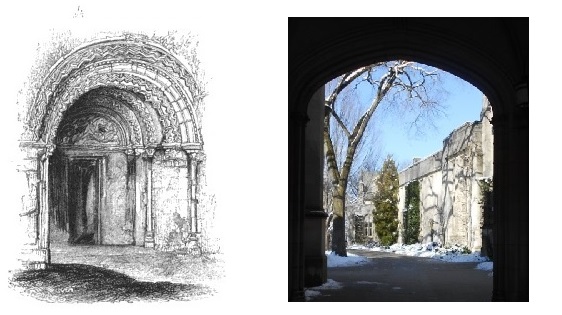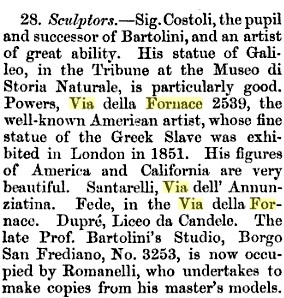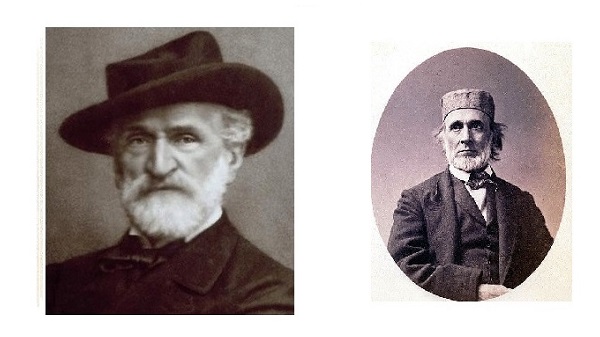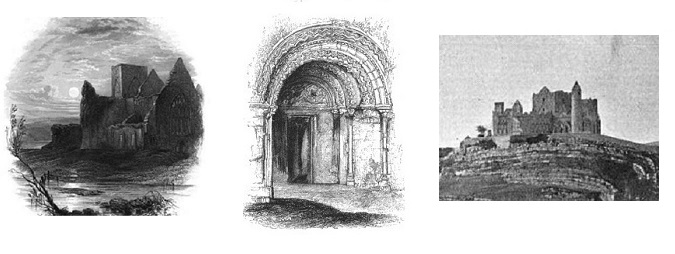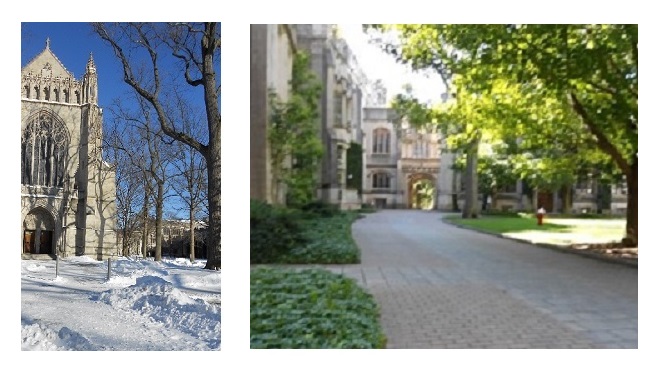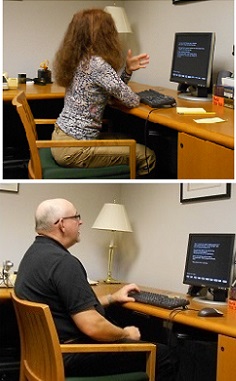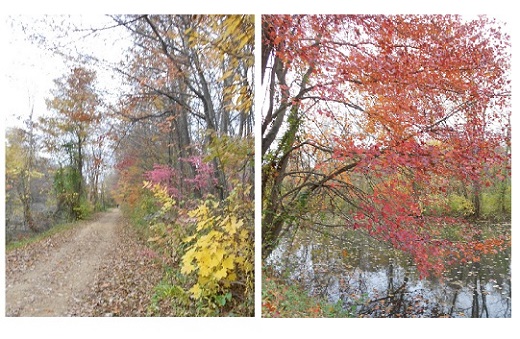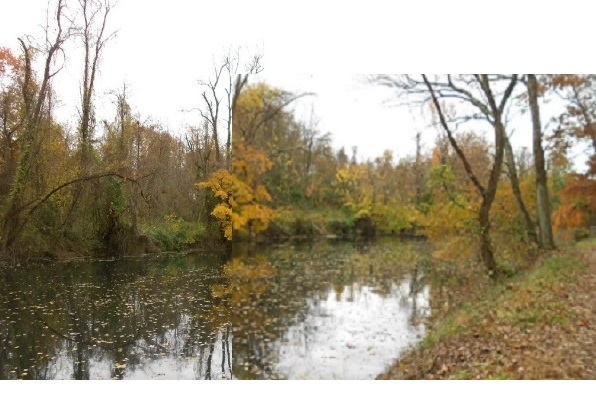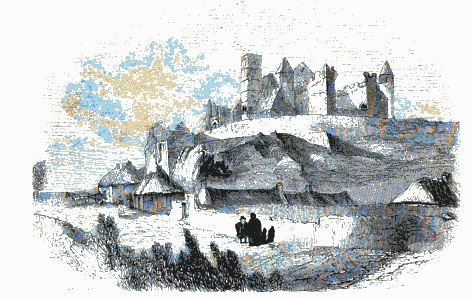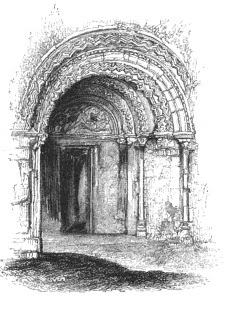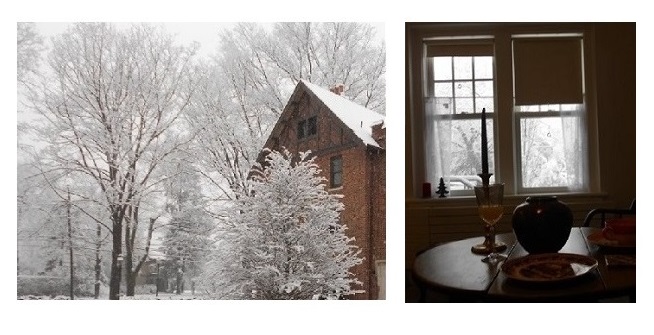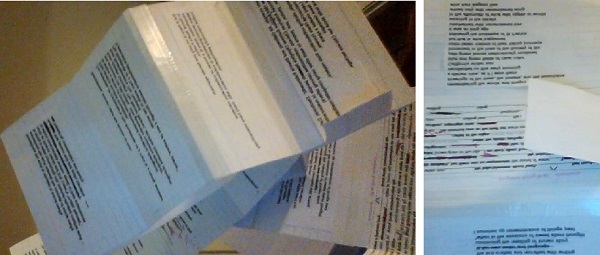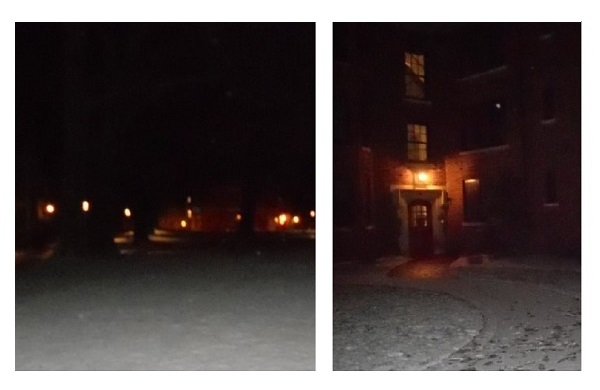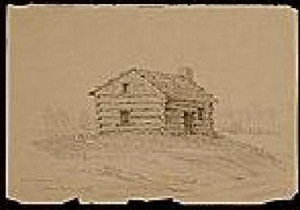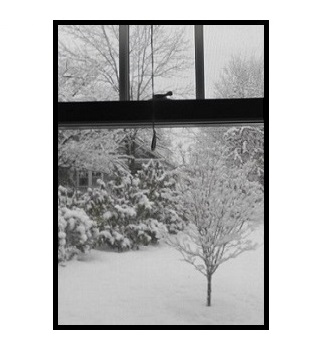
|
Judy Malloy:
January 9, 2014 E lectronic Literature has come of age in many ways. For me it is a continued focus on the distinction of screen-based story set in motion; the hunting, gathering and remixing of ancient and contemporary narrative; the thrill of creating a way to score words like music; honing the craft of telling a story in the public square of the Internet; and the interactivity of allowing the reader the choice to click rather than wait for the word music to progress. In a polyphonic 19th century remix, And Speak of Long Ago Times, replays the words of a 19th century Florentine sculptor Giovanni Dupre; replays Giuseppe Verdi's words that concern his antislavery opera Nabucco; and crosses continents to Narrative of the Adventures and Escape of Moses Roper from American Slavery which was published in London in 1837 and went through at least 11 editions. It is 1842. Hiram Powers is in his studio in Florence, creating The Greek Slave. The Irish woman poet Frances Browne has just published "Songs of Our Land" in the Irish Penny Journal. Her words echo in a 21st century art historian's untutored translation of the chorus of Hebrew slaves from Nabucco: "Va Pensiero". It is 2013. Liam O'Brien is in a coffee house in New Hampshire, reviewing his notes. fiddlers_passage, the authoring system for And Speak of Long Ago Times, uses the innovative text-based musical composition system that I began in 1991 with Wasting Time (After the Book, Perforations 3, Summer, 1992) and resumed in Berkeley in 2009 under the influence of early music performance. The Fiddler's passage scoring systems was begun in 2012 when Willi Apel's, The Notation of Polyphonic Music 900-1600, fell open a page in the chapter on Franconian Notation, where a facsimile from the circa 13th century Montpellier Manuscript was displayed: "huic ut" in which the magi bring mystical gifts..." I have for many years been working with the oral literature aspects of telling a story in the Homeric tradition, in an electronic community or "town square" of people seen and unseen. And Speak of Long Ago Times is part VI of my continuing epic work of public literature: From Ireland with Letters. And Speak of Long Ago Times can be read either by watching the words play like a piece of music or by clicking on the words to advance the narrative in a way that the reader choses. In the latter case, there will be times when the music is silent. Wait, and it will return. The score is at http://www.well.com/~jmalloy/long_ago/long_ago_score.html U sing the score, today (my birthday) I completed a working draft of the complete lexias that comprise And Speak of Long Ago Times There will, of course, continue to be editing of the text until the whole flows perfectly for my vision. And then there will be references and sources to add to the "about" file. T he first complete build of And speak of long ago times is finished. The about page has been augmented; the whole has been attached to the main menu of From Ireland with Letters. So ends my writer's notebook for And speak of long ago times. Except for this entry, it is now rearranged to begin at the beginning and end on January 24, 2014.
May - August, 2013
Setting the Stage for And speak of long ago times
"Va, pensiero, sull'ali dorate; F ollowing the trail from 19th century Florentine sculptor Giovanni Duprè's meetings with Giuseppe Verdi; [1] following the trail of the central role of opera in Italian culture in the 19th century, [2] in the late Spring of 2013, I looked at a timeline of Verdi's operas and observed that the creation of Hiram Powers' The Greek Slave paralleled the creation of Verdi's Nabucco, which he wrote in 1841 and premiered at La Scala in Milan on March 9, 1842. The origins of Nabucco are documented by the composer himself in Giuseppe Verdi, An Autobiographical Sketch. "...Back home, I threw the manuscript on the table with an almost violent gesture, and remained standing before it. In falling, it had opened itself; without my realizing it, my eyes clung to the open page and to one special line:" 'Va, pensiero, sull' al' dorate'" [3, p. 89] ...when the chorus of Hebrew slaves first sang "Va, pensiero"... W hat exactly happened when the chorus of Hebrew slaves first sang "Va, pensiero", in occupied Italy on March, 1842 in Milan at La Scala, is the subject of various legends. Some say that the singers in the chorus confronted the Austrian guards, and the audience joined them. Some say it was the workmen during rehearsals who began the applause for "Va, pensiero". Others say that the audience rose to their feet shouting "Viva Italia".
Encores were forbidden by the Austrian occupying force. Nevertheless, it looks as if there was an encore performed at the premiere of Nabucco, but it was for "Immenso Jehova", near the end of Act 4, the final act. (and not specifically for "Va, pensiero") It should also be noted that the lyricist for Verdi's Nabucco was composer and poet Temistocle Solera, whose father, a member of the Carbonari, (The IRB/IRA of the Risorgimento) had been imprisoned in Spilburk prison. (reportedly in the early 1820's along with Piero Maroncelli, Federico Confalonieri, and the poet Silvio Pellico) It is likely that the audience for Nabucco would have been aware of this. [4]
Giuseppe Verdi (photo: Giacomo Brogi) October 10, 1813 - January 27 1901; Hiram Powers, July 29, 1805 - June 27, 1873 (photo: Freres Powers); ...a fine story to set the stage for Part VI of From Ireland with Letters M eanwhile, in his studio in Florence, against a background of occupied Italy, Irish American Hiram Powers - who was creating The Greek Slave working from a childhood vision of a women in white whom he could not reach across a river, from the Greek War of Independence, from the marble copy of a bronze Greek sculpture of Venus, (the Venus de' Medici) and importantly from his strong belief in the Abolitionist cause -- was very likely to have heard of the audience reaction to Nabucco. Thus, It is possible that the impact of Nabucco may have inspired his eventual decision to send The Greek Slave on a tour across America in the years before the Civil War. For the purposes of a possible influence on Hiram Powers' decision to send The Greek Slave on tour, whether it was the reception of the evocative chorus of the Jewish slaves, "Va pensiero", or the central anti-slavery message of Nabucco as a whole is immaterial. With over 50 performances in 1842, [5] the impact of Nabucco in the Risorgimento era was likely to be observed by a descendent of an Irish slave, who was at the time creating an anti-slavery sculpture in his studio in Florence. [6]. If he had not already seen a role for his own work in pre-Civil War America, it is possible that the idea of sending The Greek Slave to America -- where it was eventually seen by over 100,000 people and became one of the icons of the Abolitionist movement -- was inspired by the continuing popular reaction to Nabucco and "Va Pensiero" during the Risorgimento. And it is a fine story to set the stage for Part VI of From Ireland with Letters.
When a writer becomes immersed in the details of his or her narrative.... C ontingently, on May 21, I went on a trip to the Music Library, where I reluctantly returned Charlotte Milligan Fox's Annals of the Irish Harpers. (NY: Dutton, 1912) With its account of Irish music in the years before United Irishmen Rebellion of 1798, in particular the July 10, 1792 Belfast Harp Festival -- attended by both Catholic and Protestant Irish patriots including James Napper Tandy, John Keogh, and Wolfe Tone -- Annals of the Irish Harpers was a primary source for the performance in Begin with the Arrival, Part II of From Ireland with Letters. After returning Annals of the Irish Harpers, at home I read a relevant document: Phillip Gossett's "Becoming a Citizen: The Chorus in 'Risorgimento' Opera". Cambridge Opera Journal, 2:1, March 1990. pp. 41-64. When a writer becomes immersed in the details of his or her narrative, such significant research events are by no means uncommon. In From Ireland with Letters, Part VI: And speak of long ago times, the narrative will shift from the Junction of Several Trails meeting of two Irish Americans (backed by a continuo of "The Rising of the Moon, "The Foggy Dew" and the literature of the Gaelic Revival) to a "passage" narrative of an Irish American sculptor who creates an iconic Abolitionist work in Florence against a background of The Risorgimento. Thus the narrator's aria in And speak of long ago times may be backed not only by a knowledge of the 80 slave narratives written by African Americans in the 19th century but also by the choruses of Italian Operas and the works of Italian writers in 19th century Italy, where and when Hiram Powers created The Greek Slave. As regards the score for And speak of long ago times A s regards the score for And speak of long ago times, it should also be noted that on the same day that I returned Annals of the Irish Harpers to the Library, I also returned Willi Apel, The Notation of Polyphonic Music 900-1600. (4th edition, Cambridge, MA: The Medieval Academy of America, 1949) And -- in addition to Roger Parker's Studies in Early Verdi 1832-1844, New Information and Perspectives on the Milanese Musical Milieu and the Operas from Oberto to Ernani, (New York & London: Garland Publishing, 1989. Parker documents the performances of Nabucco in a chapter on "The Exodus of Nabucco", pp. 111-141) -- I returned home with the notation for the opening instrumental bars of "Va Pensiero". I was looking for the full orchestral version, but for now what I found was a piano adaptation by John Rutter. Perhaps I will find what I am looking for in Princeton. In search of a title P lanning the notation meter and looking for a title for Part VI of From Ireland with Letters, I read and reread the lyrics of "Va pensiero" in Italian and in English.
The title I first selected was the line "and speak to us of times gone by" . ("ci favella del tempo che fu") I liked the echo of my own translation (in the new Eastgate iPad edition of its name was Penelope) from the beginning of The Odyssey.
"Of these events, Muse, daughter of Zeus, However, there was also an echo of À la recherche du temps perdu in the title "and speak to us of times gone by". Thus, in remembrance of Proust, whose work I have read and reread in the past, I decided that this different story should have a different title. So, I changed "ci favella del tempo che fu" to And speak of long ago times. How one phrase or word in one column of the work enhances the meaning of the flowing text as a whole I n a work of electronic poetry where the text itself is the musical component of the work, the study of the relationship of words to music is nevertheless of value to the poet because the way the text flows, the timing, the textual counterpoint are important components of the work. Thus, the issue of how text is set to music has been a reoccurring theme in the research for From Ireland with Letters. And, as always, musicologists have brought insight into the process of composing polyphonic literature. In "Becoming a Citizen: The Chorus in 'Risorgimento' Opera", (Cambridge Opera Journal, 2:1, March 1990. pp. 41-64) Philip Gossett -- who focuses in this paper on the work of both Verdi and Rossini -- observes that the words of an opera determine the dramatic tone even when they are difficult to discern in the performance. "Nevertheless," he emphasizes, "opera communicates primarily through the way its text is set to music. It is the multiplicity of ways such communication can be effected, subverted or rendered problematic that concerns me here." (p.43) A composer of polyphonic literature will not, of course, be working in precisely the same way as a composer setting a libretto to music. Nevertheless, in new media writing, the design of the page, the use of color, the timing, and especially the use of textual counterpoint are core tools in conveying the content. Indeed, in the course of writing the counterpointal text with which From Ireland with Letters is composed, I have observed how one phrase or word in one column of the work enhances the meaning of the flowing text as a whole -- for example, the place in Junction of Several Trails where "The Rising of the Moon" is quoted. As is traditional in contemporary works of Irish literature, the quoting of the names of songs and their lyrics is important to the reader's reading/hearing of the work. And -- as in the chorus in Risorgimento opera (see Gossett p. 46 for Rossini's musical quotation of "La Marseillaise" in L'Iy, contrapuntaltaliana in Algeri, Coro di schiavi)-- in such allusions to historic song, there is a cultural meaning that contributes greatly to the understanding of the work.
"Who would follow in their footsteps The words were written by Fenian poet John Keegan Casey, in memory of the United Irishmen Rebellion of 1798. "The Rising of the Moon" continues symbolic of the series of rebellions that finally resulted in the Irish Free State. And -- just as in Milan in 1842 when Nabucco was first performed, the audience was likely to know of the severe imprisonment of the father of composer and poet Temistocle Solera, the lyricist for Nabucco -- in Ireland, people were likely to know that John Keegan Casey himself was harshly imprisoned after The Fenian Rising of 1867. In Junction of Several Trails, "The Rising of the Moon" represents not only the struggle for freedom in Ireland, but also the role of art and music in the struggle to free African American slaves in America, including the over 80 slave narratives written by African Americans; abolitionist publications, and the work of the Irish American sculptor Hiram Powers, who created The Greek Slave against a background of the Risorgimento and sent her from Italy to America in 1847. _____ Notes for May-August 1. Thoughts on art and autobiographical memoirs of Giovanni Duprè; tr. from the Italian by E. M. Peruzzi, Edinburgh,London: Blackwood, 1884. 2. That Italian opera was also a part of the culture of The expatriate community in Florence is documented by John F. McGuigan, Jr. in "'A Painter's Paradise': Thomas Cole and his Transformative Experience in Florence, 1831-1832" (in Sirpa Salenius, ed., Sculptors, Painters, and Italy - Italian Influences on Nineteenth-Century American Art, Saonara, Italy: il Prato, 2009. pp. 37-51. 3. Giuseppe Verdi, An Autobiographical Sketch (in Giuseppe Verdi, the Man in his Letters, as edited and selected by Franz Werfel and Paul Stefan; translated by Edward Downes. New York, L.B. Fischer, 1942 pp in 80-93. Note that dictated to his friend and publisher Giulo Ricordi, Verdi's Sketch was created 27 years later in 1869. 4. Philip Gossett, "Becoming a Citizen: The Chorus in 'Risorgimento' Opera". Cambridge Opera Journal, 2:1, March 1990. pp. 41-64 ___Danielè Pistone, Nineteenth-Century Italian Opera from Rossini to Puccini, Portland, OR: Amadeus Press, 1995; translated by E. Thomas Glasow. 5. Roger Parker, "The Exodus of Nabucco", in Roger Parker, Studies in Early Verdi 1832-1844, New Information and Perspectives on the Milanese Musical Milieu and the Operas from Oberto to Ernani, New York & London: Garland Publishing, 1989. pp. 111-141. According to Parker, the first production, which premiered in Milan at La Scala on March 9, 1842, ran for only 8 performances, due to the end of the season. When it opened again at La Scala on August 13, 1842, it ran for 57 performances. (p.117)
6. Nabucco was first performed
on March 9, 1842 at La Scala in Milan.
It was first performed
in Florence at Teatro dell Pergola
on January 11, 1844. (Parker p. 118)
I arrived in Princeton on August 2, 2013. This notebook, begun at the time of packing and moving, was resumed in Princeton on August, 18, 2013 and continued until January 24, 2014. The picture on the right was taken on the way to my office in September at the time when the Pathfinders team was in Princeton to talk with me about the creation of Uncle Roger. The photo on the left was taken on my way to my office, the day after the January 21st snowstorm. August 18, 2013 L eaving El Sobrante, saying goodbyes, traveling to Princeton, unpacking, working on the materials for my seminar in Social Media: History Poetics, and Practice have occupied my time this summer. Now, in mid-August, with a view of the beautiful streets of Princeton, I return with pleasure to the writer's work of reviewing the research for And speak of long ago times -- Part VI of From Ireland with Letters. Incomplete and fragmented, this summer-of-2013 writer's notebook consists of many new and as yet unfollowed trails. But when a writer's life changes, such new experience is important in the creative process. For a writer of hypernarrative, new trails (both followed and unfollowed) traverse the interface between art and life. And so, here I am in Princeton, where I have never been before. The Chair and the Program Manager of the Program in American Studies, where I will be Anschutz Distinguished Fellow in American Studies for the fall semester, have been very hospitable. The IT people are good and helpful. A friend of the Dean of Faculty's has kindly lent me an Apple II on which I can prepare for the September visit of the NEH-funded Pathfinder's project. The campus -- within walking distance from my new residence -- is beautiful. I am thrilled and happy to soon be working with Princeton students on the history and creative uses of social media. It is an important field of study, and a field in which the students themselves will have much to contribute, This week, I am beginning to polish the rough notes written so far in this wiki-composed notebook. And soon, I will begin to structure and write And speak of long ago times.
August 25, 2013 I have begun the writing and the scoring for And Speak to me of Long Ago. The structure, the mood, I had originally envisioned have been somewhat altered. When several months go by without writing, and a writer's life is changing, this is not unusual. Currently there are three parallel tracks in Long Ago. Liam's own voice in a text aria is the central track. He is engrossed in research and scholarship. He has not forgotten his meeting with Irish American musician Máire Powers, but he has not suggested another meeting. And neither has she. The story of Máire Powers and Liam O'Brien is not progressing in the inevitable way that was expected. With a primary thread of the role of Italian opera in the Risorgimento, and in particular Verdi's Nabucco, which was (while Hiram Powers worked on The Greek Slave in his studio) the talk of Italy, a narrative of the work of artist and composer colleagues in Italy proceeds in parellel with Liam's textual aria. Polychoral writing is electronic literature, not music; however, there are parallels in the way that polychoral text is musically composed and experienced. In the process of writing and composing Long Ago, I am interested in Phillip Gossett's observation that the words of an opera determine the dramatic tone even when they are difficult to discern in the performance. "Nevertheless," he emphasizes, "opera communicates primarily through the way its text is set to music. It is the multiplicity of ways such communication can be effected, subverted or rendered problematic that concerns me here." (p, 43 in Phillip Gossett, "Becoming a Citizen: The Chorus in 'Risorgimento' Opera". Cambridge Opera Journal, 2:1, March 1990. pp. 41-64.) August 31, 2013 I n exploring material for the continuo in Long Ago, I have returned to looking at the importance of slave narratives in the years before the Civil War. Hiram Powers' connections with the Abolitionist movement in Cincinnati before he sailed for Florence are already set forth in The Prologue to From Ireland with Letters. Passages from Narrative of the Life of Frederick Douglass, an American Slave, appear and reappear in the narrative as a whole. This week, I have returned to exploring what slave narratives would have been read in Europe in 1842, the year when Powers was creating The Greek Slave in his Studio in Florence, and Verdi was premiering Nabucco in Milan. One of the most likely would have been Moses Roper's Narrative of the Adventures and Escape of Moses Roper from American Slavery. [1] After a series of harrowing escape attempts and extreme punishments, Roper finally escaped to England. He arrived in Liverpool in November, 1835, where, a few years after The Slavery Abolition Act 1833, he was a free man. With the help of British Abolitionists, he was formerly educated in England. His book, first published in London in 1837, went through at least 11 editions. [2] It is not unlikely that Powers - who arrived in Florence in 1837 -- would have read it. As regards the impact of first person slave narratives in the eventual freedom of African Americans, there is an anonymous editorial quote from the anti-slavery newspaper Chronotype, (edited in Boston by Elizur Wright) which I first saw in an introductory "Note" to Harriet Jacobs' Incidents in the Life of a Slave Girl.. [3] "Argument provokes argument, reason is met by sophistry; but narratives of slaves go right to the heart of men." __________ 1. Moses Roper, Narrative of the Adventures and Escape of Moses Roper from American Slavery is available online on the Documenting the American South website, sponsored by the University Library of the University of North Carolina at Chapel Hill. 2. On my reading list: Frances Smith Foster, Witnessing Slavery: The Development Of Ante-Bellum Slave Narratives, Madison, WI, University of Wisconsin Press. 2 ed, 1994. 3. Harriet Jacobs, Incidents in the Life of a Slave Girl. NY: Dover, 2001 (originally published in Boston in 1861) p. v September 10, 2013 I t is always interesting for a writer to return to his or her work of the past. Thus the visit on Friday and Saturday from the Pathfinders team -- Dene Grigar, Stuart Moulthrop and videographer Aaron Wintersong -- was not only enjoyable and a time to spend talking about the past, present and future of electronic literature; it was also invaluable. The subject was The Blue Notebook, file two of Uncle Roger, as well as Uncle Roger as a whole -- the BASIC Blue Notebook running on an Apple II; the IBM PC GWBASIC version of The Blue Notebook as emulated in DOSBox, the threads of my life and career that converged in this work. Particularly interesting, since I will begin teaching Social Media history and Poetics at Princeton this week, was how early social media both inspired and shaped this work of public literature that was first told beginning on December 1, 1986, on Art Com Electronic Network on The WELL.
Uncle Roger was essentially an interactive "jig" -- a short, comedic stream of consciousness, randomly accessed work of narrative -- begun in an online community with the intent not only of exploring a vision of nonsequential literature but also of online story telling in a social media environment, where I wanted the audience to frequently return. Indeed, If I were to search for the connections between Uncle Roger and From Ireland with Letters, I would say that they are both works of public literature. Thus a consciousness of the audience influences the flow of each of these works. It could even be the same audience. (What does A Midsummer Night's Dream have to do with Shakespeare's history plays? The comparison is, of course, not with Shakespeare but rather with told/staged narrative composed for live audiences.) I don't think that this awareness of the audience is felt by all writers of electronic literature. But in my case, the beginning of my work on Art Com Electronic Network on The WELL -- where Howard Rheingold set up a separate topic to discuss the work, and I was always aware that I was telling the story in an online community -- was important. For instance, in Begin with the Arrival, (part 2 of From Ireland with Letters) when Máire Powers performs an Irish ley, (an historically oral art form) the pub where this takes place is fictional, but at the same time I am well aware that she/I have an audience on the World Wide Web.
Dene Grigar and Stuart Moulthrop L istening to the sound and flow of my own words in the poetic way that Dene Grigar read them on Saturday, when she used the repitition inherent in the work to explore the lines of words with which it was written, and listening to the conjunction of narrative and scene-shifting constraint in the hypertextual way that Stuart Moulthrop read these same words -- I was reminded that what Uncle Roger and From Ireland with Letters have in common is 1. the use of language to draw the audience into the narrative and 2. the (Homeric?) use of multiple narrative paths to engage audience attention in the public square telling of historical narrative. September 21, 2013 F ortuitous research paths wind their way through the composition of From Ireland with Letters. Last week, while contemplating the need to define the measure for the as yet created score of And speak of long ago times, I spoke with Meredith Martin, whose idea and work for the Princeton Prosody Archive I greatly admire. In addition to the work as a model digital humanities project and the creative way in which the archive corresponds to her research, I was interested in how prosody research might relate to the scoring of From Ireland with Letters. In conversation with Meredith, two writers on this subject emerged: Sidney Lanier, whose critical works include The Science of English Verse, and Joshua Steele -- both of whom were interested in looking at poetry in terms of music. I was not familiar with the critical writing of either Lanier or Steele, whose oevre she suggested, but they are now on my reading list. Indeed, it seems likely that in the creation of constraint-based and/or performative electronic literature, the Princeton Prosody Archive will be of interest to the field as a whole. As regards my own work, because the hypertextual node is so central, notation is currently created by scoring a complete lexia as one note. (For example, see the score of fiddler's passage and the score of Junction of Several Trails. Thus, more precise syllable-based notation is not used in scoring From Ireland with Letters. What has worked (so far) is a 32 second measure in which entire lexias -- in combinations of 8,16,24,32 in order to arrive at 32 seconds (lower numbers don't work well with online servers)-- are scored as notes. The reason that some kind of notation is useful in creating this work is that in composing three or four streams of moving, parallel text, the nodes must move meaningfully in conjunction with each other, and it is difficult to maintain the desired flow of the work without precise scoring. The reader, of course, will seldom be able to read all polyphonic tracks of the work in the time allotted but rather is encouraged to replay these works several times. The same procedure is sometimes necessary when one listens to a complex piece of music. The reader also has the power to change the carefully planned flow of fiddler's passage or Junction -- just by clicking on any lexia at any time. Due to inherent linking, these works often cohere if the reader does this, but the experience is not the same. Choices between authorial control and interactivity are part of both the composing and the reading experience of electronic literature.
September 27, 2013 I n this time of other interesting and challenging work, it is important to have the score laid out and the writing underway. Once that happens, the writing usually flows pretty well. Therefore, continuing with a lexia-based adaptation of common time, I'm plotting the score for And speak of long ago times -- with reference to the score from Verdi's "Va Pensiero". (Nabucco, 1842)
But there are still some questions that need to be asked and answered, I note as
Roger Parker's poetic lecture on
Nabucco at Gresham College plays in the background. "...The melody is simple, disarmingly so: a series of symmetrical melodic phrases, with no rhythmic or harmonic surprises, just a simple alternation of dotted rhythms and triplets over a rocking accompaniment. Most surprisingly, though, the chorus sing mostly in unison, as if they are one powerful, collective voice... And I contemplate both a journey to the reference room of the music library and Parker's quoting of Rossini to the effect that "Va Pensiero" is "not so much a chorus as an aria for sopranos, altos, tenors and basses". (A contingent approach occurs over and over again in From Ireland with Letters, where although three or four *different* nodes are presented in counterpoint, they are read in the context of one voice.) As previously noted, Irish artists and writers are generally conscious of the role of song (and the under language of song) in times of oppression. Thus, in Long Ago, Liam O'Brien focuses on the significance of "Va Pensiero" not only later but also at the time when it was first performed. Clearly, Hiram Powers, working in his studio on The Greek Slave -- in 1842, the same year that Nabucco premiered in Milan -- also understood the role of metaphor in artists' statements of oppression. Ah, but it is time to return to the notation for And speak of long ago times
October 4, 2013 I n the Music Library with Roger Parker's Giuseppe Verdi, Nabucodonosor, dramma lirico in four parts by Temistocle Solera. (Chicago and London: University of Chicago Press, 1987, based on Verdi's autograph score and other authentic manuscripts) It was a heavy volumne, difficult to transfer from the stacks to the reading table. The full orchestra version of "Va Pensiero" was on pages 385-400. The appendix also included an autograph choral arrangement of "Va Pensiero". (p. 513-514) The purpose of this library journey was to check that the time signature of the original was "common time". It was. For And speak of long ago times, I am not planning to follow the score of "Va Pensiero" as a strict constraint. Rather, for this work, I am working in the way that some Irish musicians work -- listening to other works, sometimes looking at scores, incorporating melodies and words into a different whole. Nevertheless, I want some compositional contingencies between long ago and "Va Pensiero". I had originally structured only three parellel tracks (staves) for And speak of long ago times, but because the scores I had seen were SATB, (also see the quote from Rossini below) I was reluctantly considering working with four tracks. Thus, I was pleased to see that Verdi had (as was probably not unusual) scored "Va Pensiero" in several ways, generally for the vocal part scoring only Donne, Tenori and Bassi staves, with the Bass line the most different.
Now, not only am I ready to begin with three tracks, but also in long ago I might experiment with two very similar tracks.
October 12, 2013 A t about the time when I resumed in earnest the actual writing of Long Ago Times, I went to hear Irish writer Kevin Barry read in the Fund for Irish Studies series. Introduced by Irish poet Paul Muldoon, Barry entranced the audience with words of "The Fjord of Killary" from his Dark Lies the Island. In Princeton, Kevin Barry's voice was the only sound in the auditorium; his prose flowed like poetry: "So I bought an old hotel on the fjord of Killary. It was set hard by the harbour wall, with Mweelrea mountain across the water, and disgracefully grey skies above. It rained two hundred and eighty-seven days of the year, and the locals were given to magnificent mood swings." In Country Galway, a poet who hasn't written a line for quite a while tends pub at the ship of fools hotel, which (in search of the "ideal solution") he has purchased. The hotel, or so the estate agent said, was established in 1648. Outside there is a storm and the waters of the fjord are rising.
If in the audience I silently intertwined Barry's story with the story that Máire Powers retells in Begin with the Arrival, (partially quoted below) I may perhaps be forgiven, for it was Barry who chose the date that the hotel was built.
("Oliver Cromwell left England from the Port of Milford Haven
Cromwell set sail for Ireland with 35 ships;
.....Outside the storm had intensified. In the auditorium, the waters of the fjord were rising with the sound of Kevin Barry's voice. The road outside was a waterway; the hotel porch lay beneath the waters. Inside the hotel on the fjord of Killary, Mick Harty was.... ah you will have to read the story, but I will tell you that the narrator has returned from his room with an eclectic collection of CD's, and the guests have begun to dance. At home after the reading, I continued to write the opening bars of Long Ago. I reworked the image that opens the score and retranslated the first lines of "Va Pensiero" to work with the common time with which I was writing. As if in answer to the near closing lines of "Fjord at Killary": "1648 was a year shy of Cromwell's landing in Ireland, and already the inn at Killary fjord was in business -- it would see out this disaster too. Now random phrases and images came at me -- the sudden quick-fire assaults that signal a new idea --- and I knew they would come in sequence soon enough...." the following morning (predicted rainy) was sunny.
October 20, 2013 A short notebook entry is a sign that this writer's energies are now concentrated on the work itself. The posting of a first draft for the url for a the score of And speak of long ago times is a way of telling myself that someone could be reading unedited lexias and not yet set in motion measures, and I need to continue writing and editing. In my work -- and this goes back to 1986, when I first told Uncle Roger live in the conferencing system on Art Com Electronic Network on The Well -- digital narrative is honed, as it probably was in ancient Ireland, in the live telling. And retelling. Indeed, there is a difference between the intimacy of my published electronic literature (the Eastgate its name was Penelope, for instance) and the audience-influenced cadence of my public literature, such as From Ireland with Letters. Contingently, last week, it was a pleasure to have Uncle Roger mentioned in Mother Jones on Ada Lovelace Day 2013, while at the same time, the links are live to my new work From Ireland with Letters, (click on project)) in the Chercher le Texte-initiated exhibition Les littératures numériques d'hier á demain at the Bibliothèque Nationale de France, (Paris, Labo BNF) through December 1, 2013.
October 27, 2013
I
n Princeton the woods are so beautiful at this time of year
At home, it is an unexpected pleasure to read/experience student social media and digital poetics papers and projects. And I have reached the place in the creation of the score of And speak of long ago times where the writing has become an immersive experience. Thus the process of electronic writing -- the changing placement of lexias, the changing of the tempo, the way the texts work against each other -- has also become a pleasure.
One of the reasons for keeping this writer's notebook is to create an accessible memory of narrative that can be woven eventually into the work itself. This week, recollecting the story of how in the mountains a 10th century Irish harper saved his life, I returned to the March 9, 2013 entry in a previous notebook and found these words: "....it should be remembered that the bards, who were attached to Irish royal courts, were learned in history and law, as well as in music and poetry, and their works included genealogies and detailed accounts of the events of the times, as well as elements of magic realism. In Annals of the Irish Harpers, there is a story that illustrates the importance of such magical bardic detail. It concerns how in the Sliabb Echtge mountain range a 10th century harper saved his own life by calling the ghost of his former master, the poet Flann MacLonan, who in a tour de force performance "...recited a poem of one hundred and thirty-two lines, commencing: 'Delightful, delightful lofty Echtge' and followed by the history of the mountains, the warriors and tribes, who had made it their hunting ground including the famous Finn MacCumhaill and his band. Giving the names of peaks, lakes, rivers, fords, woods, he concluded with a eulogy of the Dalcassians of Clare." ______________________ (Charlotte Milligan Fox, Annals of the Irish Harpers, NY: Dutton, 1912. pp. 85-86. Her source is Eugene O'Curry's Manners and Customs of the Ancient Irish.)
November 2, 2013 I n quiet times between the exploring of autumn Princeton woods, talk with a colleague about the history of science and technology, and the pleasure of reading/exploring student papers and projects, I created the directory long_ago, (both online and offline) and into this directory, I put the draft opening file: of And speak of long ago times. The filename is long_ago.html At this time, the words with which Long Ago opens are:
"desire to make the acquaintance as soon as possible Normally I would make some unintelligible notes about the filenames on a stray piece paper and then with the score in hand, plunge into the process of creating the files and setting them in motion. Quite a few changes would be made in the score at this time. But that piece of paper would be the only documentation. Getting the work moving, immersion in the act of composing, would be the foremost considerations. This time, it was my intention to thoroughly record (in this notebook) the process of translating the score to the work itself. But once I was in the throes of the immersive process of beginning to set And speak of long ago times in motion, that did not happen. The good news is, that although the score itself does not yet reflect the inevitable changes, the draft first few bars And speak of long ago times are working.
November 9, 2013 I n the creation of polyphonic electronic literature, it is not unusual for the opening writing and parallel changes in scoring to proceed with difficulty. The process has not yet become so intuitive that the words and the implied melody work together perfectly. That will take intensive editing and writing sessions -- like the practice of a new fiddle tune -- until the work rings true. Nevertheless, about 10 new lexias have been woven into the draft, and I'm working on the revised score for the opening measures of and And speak of long ago times. In the midst of this difficult but rewarding process of translating text into implied remembered song, it was a pleasure to hear Irish musician and filmmaker Philip King, in conversation with Lewis Center Chair, Michael Cadden, talk informally about the Irish lyric -- backed by some extraordinary film clips from King's work in documenting and playing Irish Music. Celebrating the legacy of Thomas Moore, ("...in the stilly night, Ere slumber's chain has bound me") King reminded the audience that Moore grew up in the era of the 1792 Belfast Harp Festival. At the same time, with an under-language of "The Given Note, ("Coming in on loud weather...Though nothing like melody") he recalled the spirit of Seamus Heaney, who died only a few months ago on August 30, 2013. Of particular interest was King's exploration of the way that Irish music travelled to America with early immigrants, flourished in Boston, New York, Chicago, and many other places, then was played in Ireland through the magic of recording technology -- helping to create interest in native Irish music and the men and women who play it. Their music was then played in America, where it inspired Irish American musicians. This circular creative process continues. And it was in Seamus Heaney's kitchen that one of the most wonderful clips of the evening took place: the Clancy brothers seated at the poet's kitchen table -- singing, passing the music back and forth: "One pleasant evening in the month of June..." At home, I returned to my own work, seeking to weave the lyrics of Frances Browne, whose "Songs of Our Land" was published in the Irish Penny Journal in 1841, into Liam O'Brien's circuitous trail from Giovanni Duprè to Giuseppe Verdi's Nabucco to the studio in Florence where Hiram Powers began creating The Greek Slave in 1841. (perhaps with the concealed knowledge of his own family's slave heritage) To create Nabucco in 1841, Verdi put music to the words of Temistocle Solera, whose Carbonari father had been imprisoned in Spilburk prison.
"Songs of our land, ye have followed the stranger,
_________________________ 1. Following the Irish tradition of reworking songs, that Philip King noted in his lecture, Frances Browne's language is echoed in Liam's Irish American translation of the opening words to "Va Pensiero". Liam's family came to Boston during the Great Famine:
"Send our thoughts, send them on golden wings.
November 16, 2013 T his week was a short walk in the woods, a picnic of cornbread and apple cider at an abandoned cabin with historical significance; snow falling outside my window on Tuesday; bare trees and a meadow with pines on Saturday morning. It has been a good week for working on the draft text, and the revised score for the opening measures of And speak of long ago times. Now it is time to stop and edit -- and because the text is too dense, shorten certain lexias and insert pauses. All three tracks are not yet working perfectly together. Of particular interest is how, in taking the role of a male narrator in conflict, the narrative has acquired Joycean qualities of tone and woven structure that are not apparent in my female voices. Contingently, in my class, we looked at blogs through the lens of male and female voices (the opening paragraphs to Jane Eyre and Moby Dick) and how 19th century first person narratives now provide historians with the details of 19th century lives and culture. Among many other examples, I replayed Camilla Crosland's description of the Hiram Powers' Studio in Florence. "His studio," she wrote, "like so many in Italy was situated in a garden some distance from his house, and with no more disturbing noise about it than the rustle of the trees, not yet bare of their leaves, though it was the middle of October." (Camilla Crosland, Landmarks of a Literary Life, 1820-1892, London, 1893.)
November 24 2013
"Giovanni Dupre," he said out loud.
The Rock of Cashel W orking on the "about" page for And speak of long ago times, I begin with views of the Rock of Cashel in County Tipperary, the seat of Brian Boru, High King of Ireland, patron of poetry and music at Cashel and patriarch of the O'Brien Clan. The Rock of Cashel is a signifier not only of Liam O'Brien's immersion in art history but also of the legend of Donnchad mac Briain's pilgrimage to Italy and his 11th century dalliance with an Italian princess, (that might or might not have happened and might or might not have had something to do with the origins of the Powers Family.) Even for an experienced reader of electronic literature, an "about" page can serve the same function that program notes do for works of music: enhance the experience of the work by guiding the audience through the complexities of the composition of the work. This is not to say that the reader cannot listen to Bach's Art of Fugue without reading Davitt Moroney's incomparable program notes [1] or that the reader cannot listen to to Pierre Boulez' Troisième sonate pour piano Formant 3: "Constellation -- Miroir", without reading Boulez' "Sonate, Que me Veux-tu".[2] Nevertheless, such documentation of complex works of music and literature not only contributes to the experience but also inspires new paths. Because so much documentation of the work is written and rewritten in my writer's notebooks, I have not as yet created academic documentation that explains in detail the process I developed of scoring polyphonic electronic literature for From Ireland with Letters Instead, so far, the "about page for And speak of long ago times sets forth the narrative's intertwined stories of Irish American history and Italy in the 1840's when Verdi premiered Nabucco in Milan while at the same time, Irish American Hiram Powers created The Greek Slave in Florence. Contingently, I was looking for images of Florence, but instead I found a 12th century Chapel at Cashel.
1. The meaning of Stretto, for instance, in which "the main melody is heard playing against itself in another voice, so that you can hear the theme twice at the same time, but with one part starting just after the other." (Program Notes for: The Art of Fugue, Davitt Moroney, harpsichord, Cal Performances, Hertz Hall, University of California, Berkeley, April 7, 2013.) 2. or "What we must do from now on, following the examples of Joyce and Mallarmé, is to stop regarding the work as a single trajectory, traced between a point of departure and a point of arrival." (Pierre Boulez, "Sonate, Que me Veux-tu", Perspectives of New Music 1:2, Spring 1963.)
November 28, 2013 A quiet working writer's Thanksgiving Day 2013 began early in the morning with the writing of draft words for And Speak of Long Ago. Then, there was the baking of cornbread, a short hike on the trail, a mid-morning picnic. Mittens and a winter jacket. The wearing of winter clothes a pleasure after so many winterless California years.
Thinking about the many paths that Liam O'Brien follows through 19th century Italy, I went for a drive in the country and discovered another trail, a footpath through a forest along a wide brook. Remembering how beautiful the bare trees were when long ago I moved from Albuquerque New Mexico to Ipswich, Massachusetts, I sat beside a shallow pond where winter ice was beginning to form. Later, I would cut and paste some words on "Social Media Poetics: The Female Narrator" into a continuous feed lexia-based artists book structure -- echoing a talk I gave 25 years ago at a Symposium at San Jose State. Carl Loeffler, Fred Truck, Anna Couey, Robert Edgar, Steve Durland, Roger Malina, and Sonya Rapoport were all there. And it was the first time Carl, Fred, Anna, Robert and I spoke together about our work on Art Com Electronic Network. So I think the structure I am using on Monday at Princeton is appropriate.
December 10, 2013
A snowstorm in Princeton. A week of editing electronic literature. Finally an about page for And Speak of Long Ago Times has been written and added to the interface. Small edits have improved the beginning of this work, and the score has been revised. The writing will resume after my last class this week. Looking forward to hearing the working plans for my students' final projects. Begin again on December 2 with the Social Media History and Poetics panel at Princeton. Coffee with Judith Donath, lunch with Jim Rosenberg and then an evening of historical social media and algorithm poetics: from noted translator David Bellos' stage-setting opening images and narrative of Raymond Queneau's Cent mille milliards de poèmes and the prescient work of George Perec; to Victorian literature scholar Jeff Nunokawa's closing oral essay on his innovative journey creating over literary 5,000 essays on Facebook. Judith Donath, Harvard Berkman Faculty Fellow and formerly director of the Sociable Media Group at the MIT Media Lab, wove together contemporize information art installations with her own work on Data Portraits. In these works, portraits are created not by representing faces but rather with accumulated data from social networks and other sources. Jim Rosenberg, whose work was published online on Art Com Electronic Network in 1987, described the creation of his Diagram poems, based on tone clusters, and showed how words are revealed in his works of spatial hypertext, such as the Intergrams (Eastgate)
M y talk -- created with lexia-like word segments on a continuous stream of 3x5 cards -- opened with Alison Knowles' "house of dust" (Programmed by James Tenney) journeyed through (among many others) the work that Cathy Marshall and I created together at Xerox PARC, and ended with a remix reading of my own words, moving from Uncle Roger, first created on ACEN on The WELL in 1986 to my work of public literature From Ireland with Letters. We had a formal dinner at Prospect House afterwards and were joined by twenty friends from American Studies, creative writing, electronic literature, theatre, biology, computer science, and computer games. S aturday night, December 7, was a quiet evening of the missing of the playing of Davitt Moroney's University Baroque Orchestra at the University of California in Berkeley and the missing of the unforgettable clear sound of Davitt's beautiful playing of an organ concerto by Domenico Paradies on the Noack organ in Hertz Hall. S unday afternoon was a Princeton Christmas card that began with snow flurries on the way to the University Chapel, where the Princeton University Chapel Choir and the Chapel Orchestra, directed by Penna Rose, performed excerpts from Bach's Christmas Oratorio -- from an opening Sinfonia; (Bach's Cantata 29 performed by University organist Eric Plutz) to the resounding drum beats that open the Weihnachts-Oratorium; (timpani: Brett Deptula) to the beautiful echo aria performed by Abigail Kelly and Katherine Wadman as echo soprano; to the closing Choral. The other soloists were Noë Chapolard, Isabel Kasdin, and Gregory Loshkajian. After the concert, the snow falling on the trees along Prospect Avenue and the Christmas lights in the windows of the Eating Clubs were magical as I walked home.
December 22, 2013 Y esterday I returned home from Princeton University's Firestone Library with Witnessing Slavery: The Development of Ante-Bellum Slave Narratives by Frances Smith Foster. (Madison, WI: University of Wisconsin Press, 1994. second ed.) To begin with, the author's own personal journey in discovering, reading and studying slave narratives is in itself important. "Reading slave narratives had changed my life," she writes in the introduction to this second edition of Witnessing Slavery. From the point of view of And Speak of Long Ago Times, Foster's introductory notes -- that include the framing of slave narratives in the context of Old Testament Jewish slavery, as well as New Testament suffering and rebirth -- provide a link between Verdi's Nabucco, and the powerful, literate slave narratives that fostered the eventual freeing of slaves in America. Contingently, slave narratives that Hiram Powers might have read are addressed in my August 31, 2013 writer's notebook entry: "One of the most likely would have been Moses Roper's Narrative of the Adventures and Escape of Moses Roper from American Slavery. [1] After a series of harrowing escape attempts and extreme punishments, Roper finally escaped to England. He arrived in Liverpool in November, 1835, where, a few years after The Slavery Abolition Act 1833, he was a free man. With the help of British Abolitionists, he was formerly educated in England. His book, first published in London in 1837, went through at least 11 editions. It is not unlikely that Powers - who arrived in Florence in 1837 -- would have read it. __________________ 1. Moses Roper, Narrative of the Adventures and Escape of Moses Roper from American Slavery is available online on the Documenting the American South website, sponsored by the University Library of the University of North Carolina at Chapel Hill. " I have already read Roper's narrative once; it was with sorrow that this week I read it again. In this writer's notebook, in the week of Christmas, it seems most appropriate to remember his escape from slavery -- "The time I first started from slavery, was in July, 1834, so that I was nearly sixteen months in making my escape." -- and his arrival in England as a free man. "ON the 29th of November, 1835, I reached Liverpool; and my feelings when I first touched the shores of Britain were indescribable, and can only be properly understood by those who have escaped from the cruel bondage of slavery..." (p. 84) "...But I must remark, that my feelings of happiness at having escaped from cruel bondage, are not unmixed with sorrow of a very touching kind. "The Land of the Free" still contains the mother, the brothers, and the sister of Moses Roper, not enjoying liberty, not the possessors of like feelings with me, not having even a distant glimpse of advancing towards freedom, but still slaves!..." (p.87) I taly was not free at the time in 19th century history that Liam reconstructs in And Speak of Long Ago Times. The details of flogging, imprisonment, and execution meted out to Italians who opposed the occupation of their country will occur later in the narrative. But it should be remembered that the lyricist for Verdi's Nabucco was composer and poet Temistocle Solera, whose father, a member of the Carbonari, was incarcerated in the notorious Spilburk prison. As the text in And Speak of Long Ago Times moves from the early 1840's in Italy at the time when Verdi's Nabucco premiered in Milan and Hiram Powers was creating The Greek Slave in Florence, it should also be remembered that in America, it was predominantly a time when the horrors of slavery were unravelling in narratives written by escaped slaves themselves. Their firsthand accounts -- of relentless torture, punishment, and rape, and of the heartless breaking up of families -- were making their way around the world, setting the stage for the beginnings of freedom.
H
ere in Princeton, I walked home from the Chapel on Christmas eve.
January 1, 2014 W orking on the second part of And Speak of Long Ago Times A draft score has been created. Much work remains to be done. In the midst of his divergent research environment, Liam O'Brien finally sees Hiram Powers more clearly, So do I. It is a poetic historical narrative technique - explore the environment, the people, the culture with many different sources until you begin to see it more clearly. If at times it seemed as if my struggle -- to see Hiram Powers not through the eyes of his letters to patrons or the accounts of travelers, but through his own life and through the lives of his contemporaries in 19th century Italy -- seemed a diversion, it was not. In the end, Powers the man in that place at that time became clearer.
The first residence, in Ohio, of sculptor Hiram Powers From 1839-1852 (in one dwelling) and 1852-1868, (in another dwelling) Hiram Powers lived on the Via Fornace in Florence, which is now the Via Serragli -- across the Arno, near the Boboli Gardens and about two miles from where Giovanni Duprè lived on the street which is now the Via Giovanni Duprè.
In the studio with him _____________________
Information about the Italian sculpters who worked with Powers is in Rebecca Reynolds, "'No Ordinary Hands': Hiram Powers' Artistic and Professionally Related Family".
in Sirpa Salenius, ed., Sculptors, Painters, and Italy
- Italian Influences on Nineteenth-Century American Art, Saonara, Italy: il Prato, 2009.
pp. 53-66.
"It is a pretty place to live,"
"We have orange and lemon trees
"....we go to see the sunset _____________________
The quotes are from:
January 24, 2014 In my life, it is a time of completion and of new beginnings. My students in Social Media History, Poetics, and Practice have created extraordinary, innovative, and interesting projects that I have very much enjoyed exploring. At the same time, abstracts are coming in for my book on early social media in the arts and humanities, and it is a continuing pleasure to interview former Art Com Electronic Network (ACEN) Sysop, Fred Truck. We have reached the time of the publication of John Cage's First Meeting of the Satie Society online on the ACEN menu in 1987. In a month or so I will begin a new notebook for the Part VII of From Ireland with Letters. In Part VII, Máire Powers will create a narrative of the story of the 17th century meeting and eventual marriage of Puritan Trial Shephard and Irish slave Walter Power. I am familiar with the places where this takes place. I lived in Ipswich where 17th century houses still stand, I spent time with relatives in Marblehead, and I remember walking on the small beach near the harbor, where the young Irish and Scottish slaves were unloaded. I have already spent some time studying 17th century life in Massachusetts. But, there are many books I need to read, and the research itself will be an interesting story. I will begin in the Princeton University Library.
|
May 3 -New Authoring Software page on Social Media Community created and announced.
May 3 - UBE final 2013 Spring Concert
Parallel pedagogical
issues: different instruments; PowerPoint for the Pedagogical Colloquium at E-Poetry 2013 in London sent to Maria Mencia and approved May 7 - The statement and the bio for From Ireland with Letters at ELO 2013 in Paris have been sent to Phillipe Bootz and Chercher le Text! May 8 - email discussion with Willard McCarty about the first issue of HUMANIST Lunch with Arts Wire friends. Wonderful Indian food in Berkeley, and we talked about Princeton and social media. Stopped to say hello to Doug at the Berkeley Art Museum. He is retiring soon and going on interesting trips with his partner this summer. I have been saying hello to Doug at the bookstore for almost 30 years and will miss seeing him. But then, I am leaving too and who knows if and when I will return. May 10 - talked on phone with Sonya Rapoport about her upcoming show at the Fresno Museum. She is going to the opening, and I look forward to hearing about how it went. Spent some time with Danielè Pistone, Nineteenth-Century Italian Opera from Rossini to Puccini, a book (Portland, OR: Amadeus Press, 1995; translated by E. Thomas Glasow) which is composed in three parts: The Librettos, The Music; Performance.
May 11 - a walk into a beautiful redwood forest. May 11 - interested in how Jay Bushman created The Good Captain. Question: Does the audience know how he created this work? Email discussion with Alistair Riddell about his current work. Listened to "Va, Pensiero" 3 or 4 times. Need to find score that includes instrumental opening.
May 12 - Mothers Day
Need to figure out how to structure Part VI; A new "about" page for fiddler's passage that includes sources for notation email talk with Deena Larson and an image for her Pines at Walden Pond
May 14 - for
Social Media Community: Working on a new "about" page for Junction of Several Trails Looking forward to seeing Vassar webmaster and early hyperfiction pioneer Carolyn Guyer when I am Princeton May 16 - Thoughts of archivists and my text continuo work inspire the form of this new writer's notebook. The problem of having to write an entry every week is alleviated by one continuous, continually wiki-edited May-July 2013 entry.
A visit with a family; May 17 - Waterway walk; California hills in the distance; a frugal picnic; & the pleasure of creating 2"x2" drawings And along the way I considered the similarities between the Society of Six (painting, wine, and pasta) and the Homebrew Computer Club. May 21 - A trip to the Library in search of the instrumental opening to "Va Pensiero". Returned home with Rutter's piano version, which was not what I was looking for but I can probably begin working with this. Also returned home with Robert Parker's record of the dates and places where Nabucco was performed. In Florence, it was performed at La Pergola beginning on January 11, 1844. May 22 - Reading: Phil Gossett, "Becoming a Citizen: The Chorus in 'Risorgimento' Opera", Cambridge Opera Journal, 2:1, March 1990. pp. 41-64 May 23 - A memorable day: lunch with family and a beautiful view. May 26 - A walk to a place of tall grass and pines, a Florentine cookie, and a 2"2 drawing of distant hills. May 27 - Continued working on the documentation for From Ireland with Letters for ELO 2013 in Paris
May 28 - A week of moving to Princeton details, May 29 - My copy of Irish poet Ciaran Carson's classic Last Night's Fun, In and Out of Time with Irish Music (NY: North Point Press, 1996) arrived in the mail, and I began to read it. 
|
